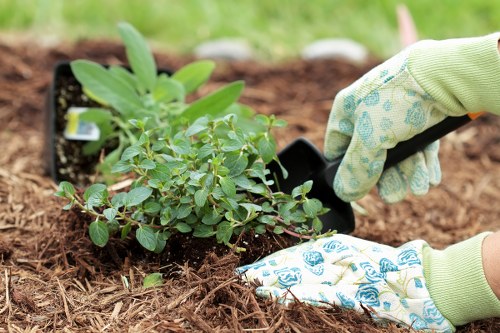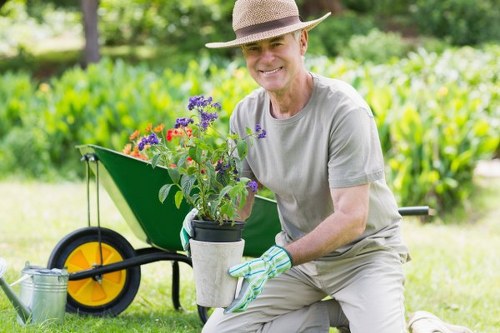Gardeners Kensington: Nurturing a Greener Future
Gardeners Kensington: Nurturing a Greener Future

Gardeners Kensington is a vibrant celebration of nature, history, and community involvement in one of London’s most iconic boroughs. Landscaping and horticulture have been vital parts of the local culture and economy, influencing how residents and visitors appreciate green spaces. In this article, we explore the heritage, current innovations, and sustainable practices of gardening within Kensington, highlighting how a combination of passion and care nurtures each garden.
For many locals, gardening is more than a hobby – it is a way of life. The gardens of Kensington have witnessed remarkable transformations over the centuries. From meticulously planned Victorian parklands to modern urban sanctuaries, every leaf, flower, and tree reflects a piece of the area's rich history. This article will help you explore different aspects of gardening techniques, community gardens, and practical tips to maintain your own garden.
Over the years, Gardeners Kensington has become a symbol of environmental respect and active participation. Local enthusiasts and professional horticulturists work together in a tight-knit community that values both tradition and innovative green solutions. Whether you’re an experienced gardener or just beginning, understanding the legacy and practices behind this initiative can inspire a deeper connection with nature.
History and Heritage of Gardening in Kensington

The story of gardening in Kensington dates back to the 18th and 19th centuries, when landscaped gardens formed the core of many private estates and public parks. Gardeners Kensington captures this rich tradition by preserving elements from some of the oldest gardens in the area. Many of these green spaces reflect the elegance of Georgian and Victorian designs, symbolizing a delicate blend of scientific horticultural methods and artistic landscaping. Historical techniques such as formal hedging, ornamental flower beds, and elaborate water features are still admired today.
Over time, the evolution of gardening practices in Kensington mirrored social and cultural changes. With industrialization and urbanization, large, open spaces gave way to more compact and innovative community gardens. This shift brought forward sustainable methods and the idea of reusing limited city spaces efficiently. The legacy of historical gardens has enriched the local identity, making gardening not just a hobby but a living piece of history.
Today, heritage garden sites are well-kept and serve as a reminder of the meticulous work done by earlier generations. Visitors and local residents enjoy spring blooms and autumn colors that echo the traditions of a bygone era. The careful restoration and preservation efforts result in neighborhoods that tell stories of perseverance, art, and the love of nature. This deep connection to the past continues to influence modern gardening trends that find inspiration in age-old practices.
Modern Practices and Green Innovations in Kensington

In recent years, Gardeners Kensington has embraced modern techniques to boost sustainability and efficiency in urban landscaping. Advances in technology have provided innovative ways to care for green spaces. For example, water-saving irrigation systems, solar-powered garden lights, and composting facilities have become more popular among enthusiasts. These technologies not only conserve resources but also add a touch of modern design to traditional garden aesthetics.
Local experts emphasize that modern gardening is a blend of classic techniques and scientific progress. Initiatives like urban farming, rooftop gardens, and community allotments have redefined what gardening means in an urban context. These initiatives showcase the potential for private and public spaces to contribute to the biodiversity of Kensington while supporting local food production and reducing carbon footprints.
With the integration of smart garden management systems, many community gardens now monitor moisture levels, sunlight exposure, and nutrient content in real time. This unique combination of tradition and innovation is a hallmark of Gardeners Kensington, making it easier for anyone to cultivate a green space that thrives year-round. Using eco-friendly compounds and organic fertilizers further enhances the health of plants, providing a reliable blueprint for sustainable urban landscaping.
Sustainable Practices and Eco-Friendly Gardening in Kensington

Sustainability lies at the heart of Gardeners Kensington. Many local gardens emphasize eco-friendly methods that are kinder to the earth. By using organic fertilizers, recycling garden waste into compost, and harvesting rainwater, gardening enthusiasts are making significant strides toward a sustainable future. These efforts ensure that every corner of Kensington retains its natural charm while minimizing environmental impact.
Eco-conscious practices extend beyond traditional gardening techniques. Community groups, private home gardeners, and non-profit organizations are actively involved in planting native species and creating wildlife corridors. This surge of biodiversity not only beautifies the area but also supports the local ecosystem. Activities such as creating bee-friendly spaces and bird sanctuaries have solidified Kensington’s reputation as a green haven.
For those wanting practical advice, here is a short list of sustainable gardening tips:
- Use organic fertilizers: They help enrich the soil without the harmful effects of synthetic chemicals.
- Install rainwater tanks: These reduce water bills and conserve natural resources.
- Incorporate native plants: Native species are easier to maintain and support local wildlife.
- Practice composting: Turn kitchen scraps and yard waste into valuable fertilizer.
Community and Local Involvement in Kensington Gardens

The spirit of Gardeners Kensington is best captured by the active participation of the local community. Neighborhood events, hands-on workshops, and gardening clubs bring people together and promote shared learning. From planning seasonal planting events to organizing clean-up drives in public parks, the involvement of community members has been pivotal in transforming Kensington into a sustainable urban garden oasis.
Community-led initiatives have not only boosted local pride but have also enhanced the aesthetic appeal of the neighborhood. Residents have undertaken projects such as beautifying derelict areas and converting vacant lots into thriving garden spaces. The keenness to transform urban challenges into green opportunities exemplifies the strong sense of solidarity within the community.
Notably, these initiatives have opened doors for local experts to share their knowledge on organic gardening, pest management, and eco-friendly landscaping. Workshops often cover topics like planting techniques, soil management, and seasonal blooms, making them accessible and beneficial for gardeners of all ages and backgrounds. This dynamic blend of education and community spirit drives Gardeners Kensington forward, ensuring that the area remains lush and vibrant.
Urban Sanctuary: Creating Personal Green Spaces
Many residents of Kensington are turning their backyards and balconies into personal oases. Even in the densely populated urban environment, opportunities exist to cultivate small yet significant green pockets. By using containers, vertical gardens, or even window boxes filled with native blooms, residents are creating personal sanctuaries that offer a respite from city hustle.
The ability to personalize a garden fosters a strong connection to nature. Local Gardeners Kensington initiatives provide useful toolkits, DIY instructions, and hands-on training sessions that make gardening less intimidating for beginners. Whether it’s a modest herb garden or a mini flower sanctuary, every effort counts and enhances the quality of life.
This approach to urban gardening not only improves beautification but also promotes mental well-being. Numerous studies confirm that spending time in green spaces can reduce stress and anxiety. By cultivating even a small personal green space, Kensington residents gain the calming benefits of nature, making urban living more enjoyable and less frenetic.
The Impact of Seasonal Changes on Gardens
Seasonal variations play a significant role in the rhythm of garden life in Kensington. Each season brings its own challenges and rewards for gardeners. Spring is a time of renewal, where the burst of color from blossoms inspires hope and rejuvenation. During this period, gardeners focus on planting new blooms and refreshing their green spaces, eagerly anticipating nature’s unfolding spectacle.
Summer in Kensington is marked by long, sunlit days. This season demands extra care, such as regular watering and pest control. Gardeners must monitor their plants closely to prevent issues such as heat stress and dehydration. The summer months are also a time for community gatherings in open-air spaces, where local events celebrate the abundance of the season.
As autumn descends, gardeners transition from growth to preservation. The cool, crisp air and falling leaves signal a time for harvesting seasonal produce and preparing gardens for winter. With a mix of practical tips and community advice, Kensington residents learn how to mulch, prune, and protect their gardens during the colder months. The cyclical nature of gardening underscores the resilience and adaptability of both plants and people in this vibrant community.
Gardening Tips and Expert Solutions for Kensington Residents
Whether you are a seasoned horticulturist or a curious beginner, having a few reliable gardening tips can make all the difference. Gardeners in Kensington have embraced a diverse set of agricultural practices that suit the challenges of urban life. From choosing the right plant varieties to understanding soil composition, simple steps can lead to thriving green spaces.
One expert suggestion is to tailor your gardening practices according to the micro-climate of your specific area. Kensington’s urban settings often have variations in sunlight and moisture. Adopting methods such as raised beds or container gardening can optimize conditions for plant growth. Local experts also advise using organic pest control methods – a mix of biological and cultural practices that prevent unwanted insects while preserving beneficial species.
Another key tip is the importance of planning. Garden planners suggest spending time each season reviewing your garden’s layout and making necessary adjustments. Maintaining a garden diary to track bloom cycles, fertilizer applications, and weather variations can be extremely beneficial. By combining traditional wisdom with local expertise, residents can achieve excellent results. Practical, clear advice makes each gardening journey a learning experience that benefits both the individual and the community.
Local Relevance: Exploring Neighborhoods Around Kensington
The influence of Gardeners Kensington is not contained by borders; it extends to many areas near the borough. The gardens and green initiatives are often inspired by the local charm of each neighborhood. Residents in and around Kensington have been able to share ideas and techniques, further strengthening the local culture of urban gardening.
Here we explore some nearby areas that contribute to the rich mosaic of Kensington’s green landscape. Each area offers its own unique features which enhance the gardening experience. From artistic communities to historical neighborhoods, these places complement the essence of Gardeners Kensington by providing inspiration, talent, and shared passion for nature.
The list below highlights several neighborhoods located close to Kensington along with their distinctive traits. Their proximity to Kensington has encouraged a vibrant exchange of gardening ideas and community projects:
- Notting Hill: Famous for its colorful houses and lively markets, Notting Hill inspires creative garden designs.
- Holland Park: Known for its quiet, leafy streets and historic parklands, perfect for contemplative green spaces.
- Wimbledon: A bit further south, offering a mix of suburban greenery and traditional English gardens.
- Chelsea: An affluent area where innovative garden design meets classical elegance.
- Fulham: Offers a strong sense of community with plenty of shared gardening spaces and allotments.
- Earl's Court: A bustling and diverse area, providing opportunities to create small, urban sanctuaries.
- South Kensington: Renowned for its museums and institutional gardens, this area enriches the cultural context.
- High Street Kensington: With a blend of modern and traditional elements, it reflects the evolving nature of urban horticulture.
- Paddington: A lively neighborhood with numerous community-led projects and green initiatives.
- Stamford Brook: A lesser-known area known for its serenity and well-kept, inviting garden spaces.
FAQs
- What is Gardeners Kensington?
Gardeners Kensington is a community initiative that promotes sustainable and eco-friendly gardening practices in the Kensington area. It embraces a rich heritage while incorporating modern innovations to enhance urban green spaces. - How can I start my own garden in Kensington?
Begin with researching your local micro-climate, choosing native plants, and considering container or raised bed gardening. Local workshops offered by the community provide useful tips and hands-on guidance. - What are some sustainable practices I can adopt?
Use organic fertilizers, install rainwater harvesting systems, and practice composting. Native plant species often require less maintenance and better adapt to local conditions. - Are there community events related to gardening?
Yes, Kensington hosts various events such as seasonal planting workshops, garden tours, and clean-up drives that encourage local participation and shared learning. - What nearby areas influence gardening trends in Kensington?
Neighborhoods such as Notting Hill, Holland Park, Wimbledon, Chelsea, and Fulham contribute greatly through their distinctive aesthetics and community-driven green spaces.